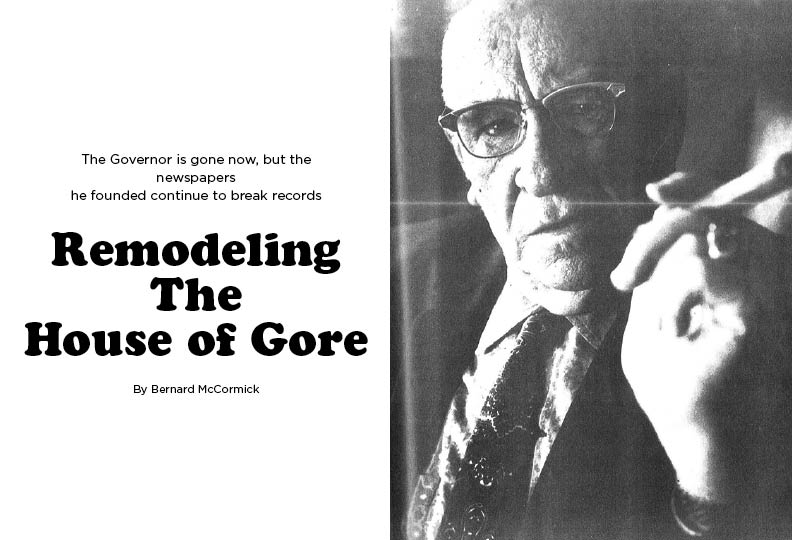Newspaper decline—by the numbers

Once upon a journalistic time—the 1970s—South Florida newspapers were among the most successful in the country. The Miami Herald, owned by the Knight Ridder company, had a statewide presence with several bureaus, and had influential readers in most major Florida cities.
In Broward County alone it had a staff of 70 based in an office on Sunrise Boulevard. Its Broward circulation was an impressive 75,000. This was despite the fact that it competed with a very strong Sun-Sentinel, which at the time was one of two dailies in the same organization. The Fort Lauderdale News was the larger evening paper; the Sun-Sentinel was morning. There was also the Sun-Tattler in Hollywood, which had a respectable 50,000 circulation. The Herald also had competition in Miami from the small but feisty Miami News (ceased in 1988), which had some of the top talent in the area, and (until 1971) the Miami Beach Sun.
In terms of its Latin American coverage The Herald enjoyed the kind of respect the Washington Post does today in the nation’s capital. Knight Ridder owned 31 other papers, including The Philadelphia Inquirer, which it turned from a disgraced paper under former owner Walter Annenberg into one of the best in the country. Although largely forgotten today, the company also published the small The News in Boca Raton, which it used as a training ground for its promising young reporters and editors.
R.H. Gore, a tough and highly competitive businessman who sold his company to the Chicago Tribune, had owned the Fort Lauderdale News and the Sun-Sentinel for years. The News was one of the most profitable evening papers. Gold Coast magazine detailed its clout:
“Figures for the first eight months of 1973 show the Fort Lauderdale News running first in total advertising lineage among all the evening papers in the country.” The only papers with more advertising were all morning sheets.
It later became a morning paper and the name Sun-Sentinel was adopted when the two papers merged in 1982. Serving a fast-growing market of Broward and south Palm Beach County, its Sunday circulation reached more than 300,000.
The Sun-Sentinel did not have the journalistic clout of The Herald, but it did a good job on the bread and butter news, such as local politics and high school sports coverage.
The Palm Beach Post was also a very successful product, although its growth was stunted by competition from the Sun-Sentinel, which moved aggressively to dominate the southern half of Palm Beach County, and papers on the Treasure Coast, which limited its growth to the north.
Those glory days are long gone. As Dan Christensen recently reported on his Florida Bulldog blog, all three papers continue to lose circulation. Although located in high growth markets, the papers are losing readers faster than the national average. Virtually all newspapers are suffering. The pain began in the 1990s and has gotten worse year by year, as the internet and expanded television news have made print publications relevant to far fewer people, and have virtually destroyed the profitable classified advertising sections.
The numbers are grim: Christensen reported the Herald’s daily circulation has dropped in the last decade from 164,000 to 53,000, although its Spanish language Nuevo Herald adds another 25,000. The Palm Beach Post just a few years ago reported a daily circulation of over 100,000; it is now around 53,000. The Sun-Sentinel is down from 100,000 to around 75,000.
Like papers all over the country, South Florida’s dailies have gone digital, which although increasing readership, provides nothing like the print editions’ income.
Shortly after Florida Bulldog’s report, Buddy Nevins, commenting on Christensen’s work, reported on his popular Broward Beat blog that the Herald and Sun-Sentinel were considering a merger, which would likely result in staff reductions (which have already been drastic) as well as lack of competition.
Christensen and Nevins, by the way, are friends. They both have strong newspaper backgrounds—Nevins at the Sun-Sentinel and Christensen at The Herald. Their work helps fill the void left by the newspaper's demise. Nevins continues the political commentary, which distinguished him at the Sun-Sentinel. Christensen’s investigative reports command a loyal audience, which has grown beyond South Florida. Notable has been his dogged pursuit of an apparent cover up of the 9/11 attacks—the possible involvement of members of the Saudi Arabian royal family who were living in Sarasota. They had been in touch with several of the hijackers, and left the country in a hurry, leaving cars and household furnishings behind, just before the attack. This suspicious information was never given to former Sen. Bob Graham, who headed the 9/11 investigating commission. He has worked closely with Christensen in the effort to pierce the secrecy surrounding that tragic morning.
Back on topic, Buddy Nevins’ rumors are usually pretty reliable, and if the two major papers do merge, the Miami Dade-Broward market, which in the early 1970s had six daily newspapers, will be down to only one. No wonder the term “low information” is being applied to so many of our paperless citizens.
